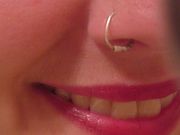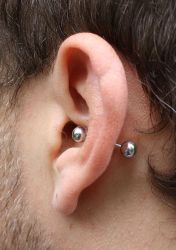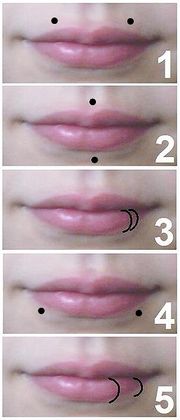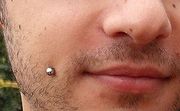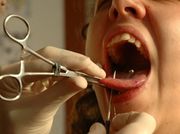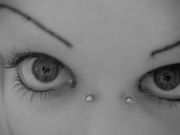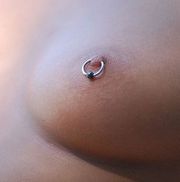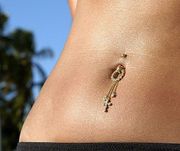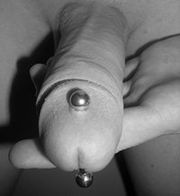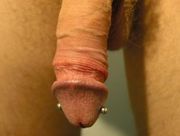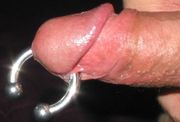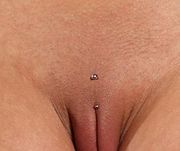About Piercings
About Piercings
Body piercing is a form of body modification. It involves piercing a part of the human body and subsequently inserting and keeping a foreign object in the opening until the wound heals. This forms a tunnel of skin (called a fistula) around the foreign object, thus creating a suitable place for wearing different types of body piercing jewelry. The term "piercing" typically refers to this hole. One example of this process is the common ear piercing. Some cultures practice piercing as part of religious traditions. In industrialized countries, most piercing is performed for ornamental or sexual reasons.
Types of piercings
Facial piercings
Nose (or Nostril) Piercing
Nostril piercing is a body piercing practice often associated with India. In India the outside of the left nostril is the preferred position of the piercing as this is supposed to make childbirth easier. Nostril piercing has become popular amongst the industrialized nations, as have other forms of body piercing. Celebrities such as Madonna and Sinead O'Connor have their nostrils pierced.
It was first performed in the Middle-East about 4,000 years ago. From there it spread out to India in the 16th century. Later on the piercing was introduced by the "hippie" culture in the 1960's and '70's. Afterwards "punks" and younger cultures in the '80's and '90's adopted this sort of piercing and even today, nostril piercing is still very popular among youth in the US and Canada.
A nasal septum piercing is less common than nostril piercings. The nasal septum is the cartilage dividing wall between the nostrils. Generally, the cartilage itself is not pierced, but rather the small gap between the cartilage and the bottom of the nose, typically at a gauge no smaller than 14ga (1.6mm). The nose has many nerves running through it and as a result, nose piercings can be painful, although it varies by individual. Septum piercing was popular among certain Native American peoples in history; the Shawnee leaders Tecumseh and Tenskwatawa, for example, had such piercings.
Yet another nose piercing is the bridge piercing. This piercing is a surface piercing through the small flap of skin at the top of the nose, between the eyes. Barbell-style body jewelery is the most common jewelery worn in this piercing.
Septum piercing was at one time performed on bulls in part of the process to break them for the farm.
Ear piercing
Ear piercing - An earring is an ornament that is worn in the ear. Earrings are often made out of metal but can also be made out of bone or similar hard material. Earrings are worn by both genders, although they are generally more commonly worn by women.
Earrings are attached to the ear through a piercing in the earlobe or some other external part of the ear, except in the case of a clip earring, which clips onto the lobe. The simple term "ear piercing" usually refers to an earlobe piercing, whereas piercings in the upper part of the external ear are often referred to as "cartilage piercings." Cartilage piercings are more complex to perform than earlobe piercings, and take longer to heal.
Earring components can be made out of any number of materials, including metal, glass, precious stones and beads. Earring designs can range from small loops or studs to large plates or dangling items. Earring size is generally limited by the physical capacity of the earlobe to hold the earring without tearing. People who habitually wear heavy earrings may find that over time, the earlobe and piercing stretch.
Earrings are worn around the world in most cultures, both currently and historically. Whereas most earrings worn in the Western world are designed to be removed and changed, permanent (non-removable) earrings have been used as a mark of slavery or ownership. Permanent earrings have made a come-back in the form of larger gauge rings which are difficult or impossible for the wearer to remove without assistance. In addition, locking earrings are occasionally worn by people of both genders, due to their personal symbolism or erotic value.
Lip piercing
Lip piercing is the practice of piercing one's lip with a stud (barbell or labret) or ring. This practice has some historical precedent, but is known by most as an activity of the youth.
A decorative item is worn in the piercing; commonly a single-ball barbell (also referred to as a 'post'), captive bead ring, spike or, nowadays, an inert plug. Traditional labrets were often clay disks.
The labret piercing is a relatively straightforward procedure; the lip is held away from the mouth with a clamp, whilst a hollow needle (14/1.6 mm as standard size) is pushed through, usually from inside-out. The jewelery (which should be a little larger than normal, to accommodate for swelling) is then inserted into the end of the needle, which is then removed and the jewelery fastened. Oral piercings heal very quickly and resist infection, but stick to sensible after-care, such as watered-down Listerine and/or salt-water mouthwashes, daily.
"Bites" is a term for sets of lip piercings placed in certain ways. There are a few types, as illustrated in the image:
- Angelbites: a monroe piercing on each side of the upper lip.(# 1)
- Cyberbites: a medusa paired with a labret. (# 2)
- Spiderbites: two piercings closely placed next to one another on one side of the lower lip. (# 3)
- Snakebites: a lower lip piercing, one on each side of the lip. (# 4)
- Caninebites: a piercing on each side of your top and bottom lip. (# 5)
Cheek piercing
A cheek piercing is a facial body piercing. It's done in the center of your cheek, where your dimple would be. It's considered one of the lesser seen piercings, because it's not really accepted by society. Cheek piercings are favorites of the vegetarian festivals in Phuket, Thailand where the monks enter trance and have huge piercings performed in their cheeks and go on a procession with all manner of objects inserted in them, such as anchors and 20 ft spears. In other cultures piercings through the cheek, tongue, and out the other cheek aren't unheard of. A cheek piercing is considered a more social piercing. It is usually advised to have your cheek pierced slightly higher or lower than where your teeth meet inside the mouth; if this isn't taken into consideration, then the likelihood of biting the back of the stud is greatly increased. When pierced, the cheek can swell a lot, so ensure that you use oversized jewelry when you initially get the piercing. This piercing is an external and internal piercing so you have to take care of it in and out. The recommended jewelry to use when you first get it pierced is a 16-12 gauge labret stud. The healing time for this piercing is 8-12 weeks.
Tongue piercing
A tongue piercing is a piercing, placed in the center of the tongue to avoid hitting a nerve, and to avoid damaging the "webbing", the part under the tongue that connects the tongue to the bottom of the mouth. A tongue piercing usually takes 4-6 weeks to fully heal. Aftercare for a tongue piercing is to rinse the mouth with a medical grade oral rinse or if that is not available, a dilution of 4 oz of oral antiseptic with 4 oz of water. A regular mouth wash should not be used. Over-cleaning the piercing can prevent it from healing correctly. Teeth should be brushed three times a day when the piercing is healing, using a soft bristle tooth brush.
Bridge piercing
A bridge piercing is a body piercing through the bridge of the nose. Basically, it is located between the eyes. This is a very painless piercing, normally described as "a slight pressure", but less painful than piercing of the ear lobe. The head being such a vascular area, during the piercing a good deal of bleeding may occur. This piercing is also called the "earl" after the man who popularized it. It is mostly found on "collectors" as it is an obvious and therefore "uncommon" piercing. Of very high importance with this piercing is cleanliness: your nasal passages pass below it, so it is of utmost importance that you avoid infection to this area. 14 gauge (1.6 mm) is the most common gauge for this particular piercing.
Eyebrow piercing
It may be pierced anywhere along the eyebrow from directly above the eye to the edge of the eyebrow. Eyebrow piercings are prone to migration, that is, the amount of skin taken by the initial piercing will decrease until the jewelry eventually grows out altogether. The best way to minimize migration is to get it pierced with a curved barbell - a straight barbell encourages migration. Eyebrow piercings initially turned up in the 1980's, and have been growing in popularity ever since. They are one of the only purely aesthetic piercings, having no recognized symbolic meaning associated with them. Healing time takes 6-8 weeks and are generally easy to care for. It is important to keep them very clean by keeping unwashed hands, makeup and hair away. Should the eyebrow become infected it may swell or develop a fluid-filled bump or pimple at the hole, which may be alleviated by administering soaks of warm, mild saline.
Body piercings
Nipple piercing
A Nipple piercing is a piercing, centered usually at the base of the nipple. A nipple piercing typically takes 3-6 months to fully heal.
The nipple is fleshy enough to pierce securely behind plenty of skin to prevent rejection. However, if the jewelry gauge is too thin or the piercing isn't deep enough to begin with, there is a risk of rejection. Metal allergies could cause it to reject. Problems with infection and/or too much tugging and pulling on it too much could also cause it to reject.
Proper body piercing aftercare is the primary reason for a successfully healed body modification, but overall health and how well a piercing is maintained is also a contributing factor. If an immune system is compromised, a piercing will not heal as quickly and will be more prone to infection. See also [ Nipple piercing ]
Navel piercing is a type of body piercing, allowing navel rings and other such decorations to be placed.
It is often combined with the fashion (more common for women than for men) of wearing clothes that leave the navel bare, so that the piercing decoration is displayed.
If a navel piercing is new - it should be left in until it is completely healed. It is important to the long-term health of a body piercing that it be allowed to heal completely before changing the jewelry. Once it has completely healed (usually around 2-6 months, depending on how well it is cared for), it is recommended that the original (professional) piercers remove the old ring (probably a standard captive-ball ring), and replace it with a new navel ring.
After that first initial change, provided no swelling or soreness occurs soon after , the belly ring jewelry should be able to be removed/replaced at will. Changing a navel ring is quite simple.
- Wash and sanitize hands, and the jewelry that will be inserted.
- Unscrew the ball (which is at either the top or bottom of the belly ring, depending on style).
- Insert the belly ring barbell into the piercing hole starting from the bottom (inside) of the navel (belly button) pushing the barbell up and out of the top hole.
- Screw the ball on the barbell and re-wash the whole area.
Surface piercing
Surface piercings are any body piercings that take place on the surface of the body through areas which are not particularly concave or convex, where the piercing canal transverses a surface flap of skin, rather than running completely through a piece of body tissue from one side to another.
Sometimes surface piercings are difficult to heal, because, as the body rejects the body jewelery as a foreign object, the jewelery is pushed to the surface, causing the piercing to grow out. Proper placement and jewelery selection by an experienced body piercer can help alleviate this problem.
Some interesting, or more common, surface piercings are:
- Corset piercing, normally done on the back on both sides with rings. The most common of the corset piercings is a 6 ring corset, when 3 are placed on one side and then 3 directly on the other side and then string or ribbon is criss-crossed thru the rings to give it a visual effect similar to a corset.
- Bridge piercing, located through the flap of skin covering the bridge of the nose, between the eyes.
- Eyebrow piercing, located through the fold of skin on which the eyebrow grows.
- Madison piercing, located between the breasts in the sternum area.
- Nape piercing, located on the back of the neck.
- Navel piercing, the most common surface piercing. Contrast these surface piercings with some common non-surface piercings:
- Ear piercing, located through either earlobe or any part of the cartilage of either ear.
- Nasal septum piercing, located through the thin membrane in the nasal cavity directly below the cartilage that makes up the nasal septum.
- Nostril piercing, located through the fold of skin comprising either nostril.
Male genital piercings
Apadravya piercing
Like the Ampalling, the Apadravya is a piercing that passes through the glans penis; while the Ampallang passes horizontally through the glans, the Apadravya passes vertically through the glans from top to bottom, almost always placed centrally and passing through the urethra unless it is purposefully offset. The piercing is normally done on a slight forward angle. An Apadravya is essentially a combined Prince Albert (PA) and Reverse PA (sometimes called a half-Apadravya). The jewelry is nearly always a straight barbell.
The Apadravya is one of the more intense male piercings, passing as it does through the most sensitive part of the penis; it is generally thought of as the most pleasurable for female sexual partners.
Variations include the shaft apadravya which pierces the shaft; the magic cross which is a combined apadravya and ampalling; and the apadydoe.
An apadravya is a male genital piercing which passes vertically through the glans penis, typically through the urethra, although non-centered apadravyas are also possible. The piercing is supposedly described in the Kama Sutra.
Apadravyas are sometimes pierced in two sessions, the first creating a Prince Albert piercing, and the second (after healing) completing an apadravya. (The upper half of the piercing is not the same as a Reverse Prince Albert piercing: while both pass through the same tissue, the angle is different.)
Straight barbells are the usual jewelry for apadravya piercings. The barbell must be long enough to accommodate erection, so the penis must be measured while erect before piercing, and an allowance must be made for ballooning of the urethra during ejaculation.
The apadravya piercing has been nicknamed "happydravya" for the added pleasure it is said to provide to the wearer or partner. If the penis has been subincised or meatotomized, the piercing is called a halfadravya.
The apadravya is related to the ampallang piercing, which passes through the glans horizontally. The combination of an apadravya and an ampallang is sometimes called a "magic cross".
Ampallang piercing
Ampallang is a form of male body piercing that occurs on the penis. It usually runs perpendicularly through the glans from one side to the other. It can either go through the urethra or above it. Generally held to be the most painful of male piercing.
A modified form is shaft ampallang, the difference being, it occurs in the shaft, as opposed to the glans. Thus, a potential for the ampallang ladder is created. Another form is the apadravya piercing, or even the Magic Cross piercing.
The piercings origin may be found in Polynesian culture, specifically the Dayak people.
- PA
Prince Albert piercing
The Prince Albert piercing (PA) is a form of body piercing. The PA pierces the penis from the outside of the frenulum and into the urethra. There is also a reverse PA piercing which enters through the urethra and exits through a hole pierced in the top of the glans. The piercer uses a reception tube placed into the urethra to ensure needle exits.
A nerve bundle runs along the center of the frenulum. While some piercers may choose to avoid the bundle, others do not. The piercing may be centered if the bearer is circumcised. Otherwise, the piercing will be done to the side because the skin in the area needs to be able to radically reposition itself.
The Prince Albert piercing is apparently named after Queen Victoria's consort Prince Albert of Saxe-Coburg-Gotha. It is alleged that he wore a ring attached to his penis which was then strapped to his thigh, in order to maintain the smooth line of the tight trousers that were in fashion at the time. It is very difficult to ascertain the validity of this story. No contemporary account of him adopting the practice has come to light, and many suspect that it was a myth invented by Doug Malloy who was chiefly responsible for popularizing body piercing in the USA. (It has also been suggested that the name actually refers to Queen Victoria's grandson Prince Albert Victor. This theory probably stems from attempts to link Prince Albert Victor with the Jack the Ripper murders)
The PA heals more quickly than most other piercings. Despite a popular belief that urine is infested with germs, a healthy person's urine is actually nearly sterile until it exits the body. Some believe that the frequent bathing of the piercing with (sterile) urine contributes to the healing process. Infections of Prince Alberts are relatively rare. Initial healing typically takes from one to two weeks, with full healing taking as much as nine months or more.
Some men find that the dribble caused by the PA when urinating necessitates sitting down to urinate. This is not, as might be suspected, due to the hole made during piercing, but rather is caused by urine traveling along the surface of the jewelery. The effect may be exaggerated by different sizes and styles of jewelry. This is usually not a problem when using urinals.
Another common misconception is that the PA is a painful piercing because of the high concentration of nerves in the area. However, nerves are specialized in their function, so the high concentration of nerve cells does not prove a higher sensitivity to pain. Anecdotal reports from people with PA's are that it is not particularly painful, although psychological state, adrenaline, and one's pain threshold all affect this judgment.
Prince Alberts are sometimes stretched to a 0 or 00 gauge i.e. about 11/32 inch (8 to 9 mm) diameter. Prince Alberts typically are pierced at either 12 or 10 gauge (2 to 2.6 mm). In the case of a 12 awg (2 mm) piercing, they are usually either immediately stretched, or stretched after partial or full healing. Outside of this initial stage, they are rarely seen below a 10 gauge (2.6 mm). Stretching to sizes of 6 to 4 gauge (4 to 5 mm) is probably most common.
Jewelry usually worn in a PA include the curved barbell, captive bead, and the Prince's Wand. Short curved barbells are usually about 3/8" or so length, so one ball sits on the lower side of the penis and the other ball sits at the urethral opening. This type of jewellery prevents discomfort that can come from larger jewellery moving around during daily wear.
The Prince's Wand is a particularly unusual piece of jewellery. It consists of a hollow tube with a threaded cap at the end. The tube is inserted into the urethra, and a stem is inserted through the PA piercing and into another threaded hole on the side of the tube. The general shape is similar to a policeman's nightstick. The little side stem holds the tube in place. The threaded cap, often just a ball, can be removed so the wearer can urinate through the hollow tube without having to remove the jewellery.
Female genital piercings
Christina piercing
A Christina is a female genital piercing. It is located where the outer labia meet up top, below the pubic mound. Christinas are considered surface piercings and have a high rejection rate. The recommended jewelry is a surface barbell or a circular barbell. Healing time is generally 2-4 weeks.
Princess Albertina
Princess Albertina is a term describing a rare female genital body piercing, analogous to the male Prince Albert piercing.
The piercing is made from just inside the entrance of the urethra through to the top of the vagina.
It's a tricky piercing to perform and its relative rarity can make finding a suitably experienced piercer difficult. Not all women are able to accommodate this piercing, and it may lead to a small increase in the likelihood of urinary tract infections. However, it often increases female stimulation during sexual intercourse, when motion and pressure on the jewellery cause stimulation in the nerves of the urethra.
Isabella piercing
An Isabella is a deep clitoral shaft piercing. It goes from the clitoral hood to the top of the pubic mound (where the entrance hole is for a Christina piercing). Healing time is 2-3 months. Recommended piercing jewelry is a surface barbell, which usually has to be custom made.
Piercing aftercare
- Eat small portions of food at a time.
- Never touch it unless you wash your hands first.
- Do not use any kind of tobacco products.
- No other oral contact with other body fluids.
- Your piercing should not be exposed to any cosmetics like lotion or makeup.
- After the healing period is over you can change the post to a shorter size to make it more comfortable.
- Drink lots of fluids and don't over-clean your piercing.
- The following steps should followed to speed the healing process
- Drink plenty of fluids, especially water. Eight glasses of day at the very least.
- At least eight hours of sleep a night
- Try to limit the amount of stress
- Vitamin C and Zinc supplements to help speed the healing process
- Lots of fruits and vegetables, and a multi-vitamin if needed
- To manage pain, take Ibuprofen.
| Articles related to Piercings | |
|---|---|
| Piercing methods | Contemporary piercing procedures • Body piercing materials • Stretching • Play piercing • Pocketing • Surface piercing |
| Ear piercings | Tragus • Antitragus • Snug • Daith • Conch • Helix • Rook • Industrial |
| Facial and oral piercings | Cheek • Eyebrow • Anti-eyebrow • Lip (Labret) • Lip plate • Lip frenulum • Monroe • Medusa) • Nose (Bridge) • Tongue (Tongue frenulum) • Uvula |
| Body piercings | Corset • Hand web • Madison • Navel • Nipple • Nape |
| Female genital piercings | Christina • Clitoris • Clitoral hood • Triangle • Fourchette • Isabella • Labia • Nefertiti • Princess Albertina |
| Male genital piercings | Ampallang • Apadravya • Hafada • Foreskin • Deep shaft • Dolphin • Dydoe • Frenum • Frenum ladder • Guiche • Lorum • Magic Cross • Prince Albert • Reverse Prince Albert • Pubic • Transscrotal |
| Articles related to Body Modification | |
|---|---|
| Addition to Tissue | |
| Modification of Tissue | |
| Removal of Tissue | |
| Genital Modification | |
| History | |
Chat rooms • What links here • Copyright info • Contact information • Category:Root
